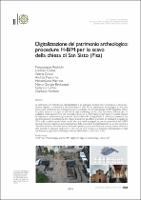Chapter Digitalizzazione del patrimonio archeologico: procedure H-BIM per lo scavo della chiesa di San Sisto (Pisa)
| dc.contributor.author | Bevilacqua, Marco Giorgio | |
| dc.contributor.author | Cantini, Federico | |
| dc.contributor.author | Cintoli, Lorenzo | |
| dc.contributor.author | Croce, Valeria | |
| dc.contributor.author | Martinez, Gianluca | |
| dc.contributor.author | Martino, Massimiliano | |
| dc.contributor.author | Piemonte, Andrea | |
| dc.contributor.author | Rechichi, Piergiuseppe | |
| dc.date.accessioned | 2024-01-11T15:42:06Z | |
| dc.date.available | 2024-01-11T15:42:06Z | |
| dc.date.issued | 2023 | |
| dc.identifier | ONIX_20240111_9788835155119_178 | |
| dc.identifier.uri | https://library.oapen.org/handle/20.500.12657/86789 | |
| dc.language | Italian | |
| dc.language | English | |
| dc.language | Spanish | |
| dc.relation.ispartofseries | diségno | |
| dc.subject.classification | thema EDItEUR::A The Arts::AM Architecture::AMC Architectural structure and design | en_US |
| dc.subject.classification | thema EDItEUR::T Technology, Engineering, Agriculture, Industrial processes::TB Technology: general issues::TBG Engineering graphics and draughting / technical drawing | en_US |
| dc.subject.classification | thema EDItEUR::A The Arts::AG The Arts: treatments and subjects::AGZ The Arts: techniques and principles | en_US |
| dc.subject.other | Transitions | |
| dc.subject.other | Cross | |
| dc.subject.other | Modulate | |
| dc.subject.other | Develop | |
| dc.subject.other | Drawing | |
| dc.subject.other | Science of Representation | |
| dc.title | Chapter Digitalizzazione del patrimonio archeologico: procedure H-BIM per lo scavo della chiesa di San Sisto (Pisa) | |
| dc.type | chapter | |
| oapen.abstract.otherlanguage | The volume, dedicated to the 44th International Conference of the Italian Union for Drawing, investigates the theme of ‘Transitions’, which particularly effectively represents our time and the current condition of the discipline of Drawing. The term, beyond its generic meaning of an intermediate stage in a process in which a condition changes from one state to another, has always been used in various fields, from music to geophysics. In fact, the disciplines of drawing have always been confronted with themes and issues relating to transitions from one condition to another. The history of representation tells us of transformations, even epochal ones, relating to ‘drawing’, with all that such transitions entail: suffice it to think of the evolution of forms of representation, of instrumental apparatuses, of the mutability of supports, of the analogical-digital transition underway, of the new modes of communication on platforms, of the hypertrophic offer of images also on the net that confirms Guy Debord’s intuitions relating to the new spectacularisation of society. Similarly, representation triggers transitions in the prefiguration and communication of design, the anticipation and foreshadowing of future events.The challenges posed by the digital pose open questions whose scope can only be glimpsed, such as the relationship between drawing and the act of modelling, and the construction of new paradigms of visual language and communication. ‘Transitions’, almost implicitly, points to possible futures, the evolution of technique and the search for new modes of expression; at the same time, however, it can suggest silences and reflections in a process of connection between history, theory, criticism and construction. | |
| oapen.identifier.doi | 10.3280/oa-1016-c452 | |
| oapen.relation.isPublishedBy | e2ddfb5e-9202-4851-8afe-1e09b020b018 | |
| oapen.relation.isPartOfBook | b51f7945-d27d-4941-b230-9b49a7d6f5cc | |
| oapen.relation.isbn | 9788835155119 | |
| oapen.pages | 19 | |
| oapen.place.publication | Milan |

